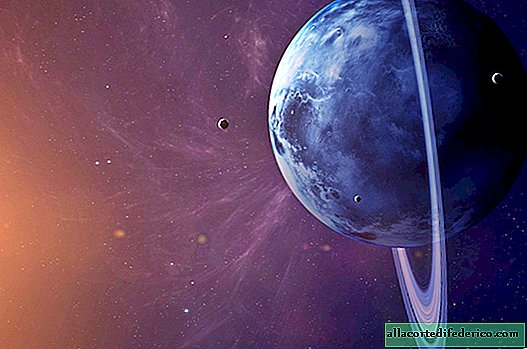The riddle of Uranus: why the planet "lies on its side"
Each of the 8 planets of our solar system has its own unique features. Someone has a dense atmosphere of carbon dioxide or extensive rings, and someone revolves around the Sun "lying on its side." It will be about Uranus and its unusual position, which haunts scientists.

Uranus is the 7th planet in the Solar System and belongs to the giant planets. Its average radius is 25 362 kilometers. It is believed that the planet consists mainly of ice: methane, water and ammonia. Hydrogen and helium are present in small amounts, and the planet’s atmosphere consists of them. Uranus has a ring system, which is not as pronounced as that of Saturn, but is still available for observation. At present, 27 satellites of the planet have been discovered.

Uranus makes one revolution around our star in 84 Earth years, and the period of rotation of the planet around its axis is 17 hours 14 minutes. But the position of this axis of rotation is very unusual. The equatorial plane of the planet is inclined to the orbital plane at an angle of 97.86º, that is, it turns out that the planet rotates as if lying on its side and as if rolling in its orbit around the Sun.

Such an unusual arrangement led to the fact that the change of seasons on Uranus proceeds in a very special way. At the time of the solstice, one of the poles of Uranus faces the sun, and at the equator there is a rapid change of day and night. Six months later (that is, after 42 Earth years), the other pole is facing the Sun. Despite the fact that the polar regions face the Sun for half a year and the Sun shines very low at the equator, it turned out that the temperature at the equator is higher than at the poles during the "polar day". What is the reason for such a temperature anomaly, astronomers have not yet been able to find out.

In addition, scientists have long been pondering how it turned out that Uranus has such a strange position. There are several versions of how this could happen. Perhaps, once Uranus had a rather large satellite, under the influence of which, the axis of its rotation underwent such changes. The satellite was lost over time, and the position of the axis remained unchanged. According to another version, at the dawn of the formation of the solar system, a large celestial body collided with Uranus, which led to the inclination of the axis of rotation.

The same version is shared by a group of Anglo-American scientists led by astronomer Jacob Kegerrey. They simulated a collision of Uranus with a large object and presented the results of their experiment. According to scientists, the collision could have occurred about 2-3 billion years ago, at the time of the formation of the planet, when it still did not have satellites. According to astronomers, the size of the celestial body that collided with Uranus was 2 times the size of our Earth. The impact could lead to a change in the position of the axis, and also affected the structure of the planet itself. As a result of the collision, Uranus lost some of the thermal energy contained in the bowels of the planet, and this can explain the fact that today Uranus is the coldest planet in our solar system. The temperature on its surface drops to minus 224ºС.

















